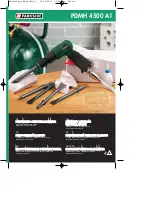
5.
Store the tool when it is idle out of reach of children and other untrained persons.
A tool is dangerous in the
hands of untrained users.
6.
Maintain the tool with care.
7.
Check for misalignment or binding of moving parts, breakage of parts, and any other condition that affects
the tool's operation.
If damaged, have the tool serviced before using. Many accidents are caused by poorly
maintained tools. There is a risk of bursting if the tool is damaged
8.
Use only accessories that are identified by the manufacturer for the specific tool model.
Use of an accessory
not intended for use with the specific tool model, increases the risk of injury to persons.
Assembly Precautions
1. Assemble only according to these instructions. Improper assembly can create hazards.
2. Wear ANSI-approved safety goggles and heavy-duty work gloves during assembly.
3.
Keep assembly area clean and well lit.
4. Keep bystanders out of the area during assembly.
5. Do not assemble when tired or the influence of drugs or medication.
Silicosis and Aluminum Oxide Warnings
WARNING!
Abrasive blasting with sand containing crystalline silica can cause serious or fatal respiratory disease.
Exposure to crystalline silica may cause silicosis (a serious lung disease); cancer and death. Exposure to aluminum
oxide (a dust generated from material removing processes) can result in eye, skin and breathing irritation. Always use a
NIOSH (National Institute for Occupational Safety and Health) approved respirator and safety goggles. Avoid skin
exposure. Proper ventilation in the work area is required. Read and understand the 10 recommended measures below
to reduce crystalline silica exposures in the workplace and prevent silicosis and silicosis related deaths.
NIOSH recommends the following measures to reduce crystalline silica exposures in the workplace and
prevent silicosis and silicosis-related deaths:
1. Prohibit silica sand (or other substances containing more than 1% crystalline silica) as an abrasive blasting material
and substitute less hazardous materials.
2. Conduct air monitoring to measure worker exposures.
3. Use containment methods such as blast-cleaning machines and cabinets to control hazard and protect adjacent
workers from exposure.
4. Practice good personal hygiene to avoid unnecessary exposure to silica dust.
5. Wear washable or disposable protective clothes at the work site. Shower and change into clean clothes before
leaving the work site to prevent contamination of cars, homes and other work areas.
6. Use respiratory protection when source controls cannot keep silica exposures below the NIOSH REL.
7. Provide medical examinations for all workers who may be exposed to crystalline silica.
8. Post signs to warn workers about the hazard and to inform them about required protective equipment.
9. Provide workers with training that includes information about health effects, work practices and protective equipment
for crystalline silica.
10. Report all cases of silicosis to State health departments and to OSHA or the Mine Safety and Health Administration
(MSHA).
Vibration Precautions
This tool vibrates during use. Repeated or long-term exposure to vibration may cause temporary or permanent physical
injury, particularly to the hands, arms and shoulders, To reduce the risk of vibration-related injury:
1. Anyone using vibrating tools regularly or for an extended period should first be examined by a doctor and then have
regular check-ups to ensure medical problems are not being caused or worsened from use. Pregnant women or people
who have impaired blood circulation to the hand, past hand injuries, nervous system disorders, diabetes, or Raynaud's
Disease should not use this tool. If you feel any symptoms related to vibration (such as tingling, numbness, and white
or blue fingers), seek medical advice as soon as possible.
2. Do not smoke during use. Nicotine reduces the blood supply to the hands and fingers increasing the risk of vibration-
related injury.
3. Use tools with the lowest vibration when there is a choice.
4. Include vibration free periods each day of work.
5. Grip tool as lightly as possible (while still keeping safe control of it). Let the tool do the work.
6. To reduce vibration, maintain tool as explained in this manual. If abnormal vibration occurs, stop immediately.
SAVE THESE INSTRUCTIONS!
1-800-345-4545 jegs.com































